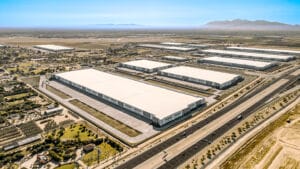A new report from a leading Arizona economist finds that the state’s economic development prospects would brighten if policymakers made the commercial property tax more competitive.

An analysis of tax rates in key markets in the Southwest and the West found that Arizona has some of the highest for office and industrial space, putting it at a disadvantage in the region.
READ ALSO: Here’s what commercial real estate experts predict for 2021
“In Arizona, the commercial property tax remains relatively high despite recent efforts to reduce the business tax burden,” said Jim Rounds, an economist specializing in public policy and economic forecasting, who prepared the report for the Arizona Chapter of the National Association of Industrial and Office Properties (NAIOP). “State tax policy must be designed so businesses can remain competitive.”
Currently, the state’s assessment ratio on commercial property stands at 18 percent versus 10 percent for residential, Rounds’ analysis shows.
“This means that office industrial, retail and other business properties are paying significantly higher property taxes than comparable residential properties,” he said.
Legislation would gradually reduce assessment ratio
To remedy the situation, Rounds recommends passage of a proposal at the state Legislature to gradually phase down the commercial property assessment ratio from 18 percent to 17 percent over the next two years.

Ideally, dropping the rate down to 15 percent over time would be a strong catalyst for investment here, Rounds said.
Business advocacy organizations statewide are in support of the proposal, including the Arizona Chapter of the NAIOP, which represents developers, owners and investors of office, industrial, retail and mixed-use real estate in the state.
“Coming out of the pandemic, there are going to be a lot of companies looking to relocate and we want the whole state of Arizona to be in that top tier of the markets that companies are going to when they are either locating or expanding into the western region,” said Suzanne Kinney, Arizona NAIOP president and CEO.
“Right now, the commercial property tax is one area where we’re simply not competitive, and unfortunately, it causes us to not make it into the final consideration for some site selectors.”
Office and industrial tax rates “through the roof”
According to the report, compared to the most popular markets in the Western United States, Arizona has the second highest commercial property tax rate for industrial space and third highest for office.
“Houston is at the top of the list, but it’s not apples to apples. They have zero income tax and extremely generous cash incentives,” Kinney said.
And while everyone is celebrating recent successes in Arizona with the semiconductor sector, most of these companies are located in Foreign Trade Zones (FTZs), which provide cost savings and incentives, she said.
“It’s a wonderful program, but it’s not available to all companies,” she said. “They are restricted to certain geographic areas and companies get a dramatic reduction in their property tax and that’s factored into their decision to choose Arizona.
“What we’re really hoping for is to broaden out the competitive nature of our tax climate so that businesses, wherever they want to locate in the state, are going to see us as a competitive market.”
Reduced tax revenues would be offset by economic growth
By dropping the tax rate from 18 to 17 percent, the Legislature estimates that the net assessed value reduction will equal $1.39 billion by tax year 2023. That represents a 1.7 percent reduction, Rounds said.
That does not mean the tax burden would have to be shifted to residential or other classifications, Rounds said. There are a number of factors that could easily offset the loss in tax revenues.
For one, other incentives currently in place for businesses could be removed or reduced down the line. Years of rising commercial property values have also increased tax revenues from the sector and that will continue with new growth.
“Statewide commercial property values have been increasing by more than 6 percent per year over the last five years,” the report states. “Thus, the anticipated growth will more than full offset any modest reductions in the assessment ratio.”
A reduction in the commercial assessment ratio of the property tax formula would result in municipalities modifying local government tax rates, resulting in a “more competitive balance” in the tax code, the report says.
History shows it works
Arizona has taken steps in the past to reduce commercial property taxes. Prior to 2006, the assessment ratio on commercial property was 25 percent.
Over the past 15 years, the ratio has gradually reduced to 18 percent. As the rate declined, the value of commercial property increased at an average annual rate of 5.1 percent between 2000 and 2020, according to the analysis.
That improved the state’s competitive position, helping fuel new economic growth and resulted in “a net gain in tax collections.”
Chambers, utilities and trade associations in support
Organizations in support of lowering the tax rate for commercial property include:
Arizona Association For Economic Development
Arizona Chamber of Commerce and Industry
Arizona Fire District Association
Arizona Free Enterprise Club
Arizona Public Service Company
Arizona Tax Research Association
Building Owners and Managers Association of Greater Phoenix
East Valley Chamber of Commerce Alliance
Greater Phoenix Chamber of Commerce
Lumen Technologies
National Association of Industrial and Office Properties, Arizona Chapter
National Federation of Independent Businesses
National Association of Commercial Real Estate Executives for Economic Development, Arizona Chapter
National Association of Theatre Owners
Salt River Project
Southwest Gas
Tucson Metropolitan Chamber of Commerce
This story was originally published at Chamber Business News.



